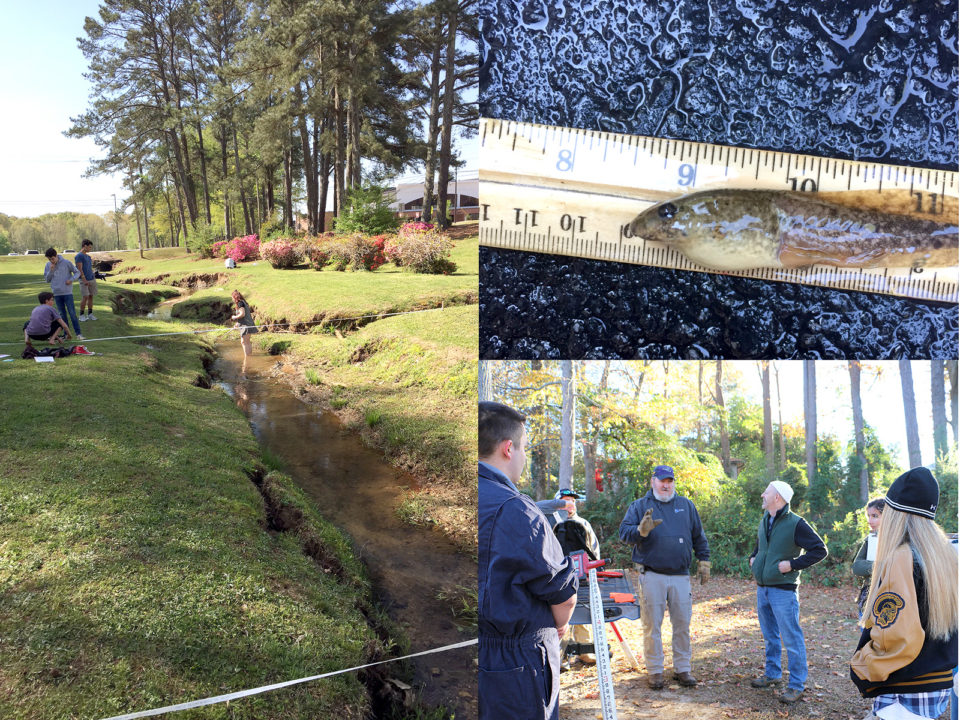
Visitors to the Carrollton City Schools campus over the past few years may have noticed some unusual activity around Buffalo Creek and its tributaries – students wearing wading boots, fishing nets in hand, splashing through the water. But what appears to be a leisurely experience rather than an academic one couldn’t be further from the truth.
Carrollton City Schools is fortunate to have many community partnerships with some garnering the spotlight early on in the relationship, while others churn in the background doing great things with little fanfare. One such partnership involves C.S. Britton, Inc., an environmental contracting company. The creek activity above is really the result of a partnership with the Carrollton-based business to expose K-12 students to the fundamentals of stream restoration. The project has been formally titled the Natural Channel Design/Buffalo Creek Project.
Scott Britton, the company’s owner and brainchild of the partnership, brought the idea to the school district a few years ago with implementation really getting under way in 2016. Britton wants students to become more aware of career options in this under-promoted field.
He also wanted to help schools enhance their science curriculum with a hands-on exposure to not only nature in all its glory, but to the scientific tools and analytical skills used in myriad science fields from ecology to hydrology to biology to environmental science.
“We need to seize opportunities to expose the students to career interests they may not know even exist, while at the same time giving them hands-on experience that potentially could develop into a real passion within them,” said Britton.
Anna Clifton, assistant superintendent of Teaching and Learning, noted the Carrollton City Schools campus is the perfect laboratory to implement this kind of hands-on learning approach.
“Buffalo Creek runs through our entire campus, so this tangible learning experience is very convenient for all of our students,” she said.
Britton said he knows not all kids are going to become rocket scientists, but they still can be strong contributors to a company’s success.
“Some kids just want to be outside,” he said. “They don’t want to be stuck behind a computer or microscope in a lab. They want to see and touch and experience what they’re working on. They want to do it, not just dream about it.”
Karen Wild, the school district’s director of School Improvement, noted by exposing the students early, they may even change their minds about the direction they want to go.
“Mr. Britton makes a great point that some students who may not have even considered college as a post-secondary consideration may change their minds if they are engaged in the sciences at a young age,” she said. “But even if they don’t become engineers, they still have the exposure and experience to join an organization as a support team member, likely paid at a higher wage because they have developed a specialized skill.”
But for all this to happen, Britton knows the classroom is paramount – so he put his resources to work. This past spring, Britton’s company paid for four science teachers – CHS’s Tim Hawig, CJHS’s Ashley Soulsby, CMS’s Moses Mitchell and CES’s Annette Perkins – to undergo the same Level One training his employees go through. And he attended himself with the specific goal of listening to the teachers discuss curriculum potential after hours, bouncing off idea after idea with one another.
“That was probably my favorite part of the whole thing,” he said, referring to the enthusiasm and excitement the teachers expressed. “They were getting it.”
Hawig agrees. He said it was an exceptional experience and looks forward to the Level Two training next spring.
“Scott Britton has really been a catalyst in getting us to think more outside the box,” he said. “His knowledge is exceptional and I am so appreciative of his commitment to helping our students – and our teachers.”
Britton further expanded his reach to teachers at the beginning of this school year by offering grant opportunities to other teachers who may want to incorporate in their classrooms projects that specifically impact interaction with the local watershed, starting as early as kindergarten.
The University of West Georgia is also involved in this grant program, which encompasses an educational development component.
“An integral step in building capacity and instructional practice is the collaboration with the University of West Georgia on curriculum design and development,” said Wild. “Our teachers will be involved in professional learning sessions to offer classroom and state standards perspectives as instructional units, lessons and activities are developed through collaborative efforts. The funding for teacher attendance at the professional learning sessions will be provided by our school district through stipend awards funded through this grant program.”
Clifton said the school system will find out next month which proposals were accepted, with implementation soon following.
“This grant opportunity is a way for teachers to figure out how more emphasis on environmental science and similar disciplines can take advantage of children’s innate curiosity and introduce them to fields of study that one day may lead to a career pathway,” said Clifton. “We really appreciate C.S. Britton, Inc. for investing in our schools – and our future – in this way.”





